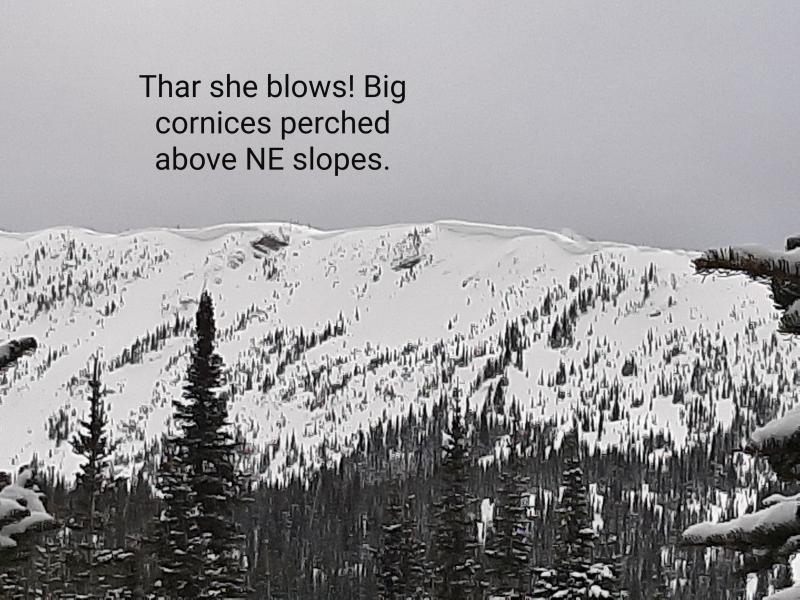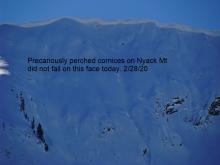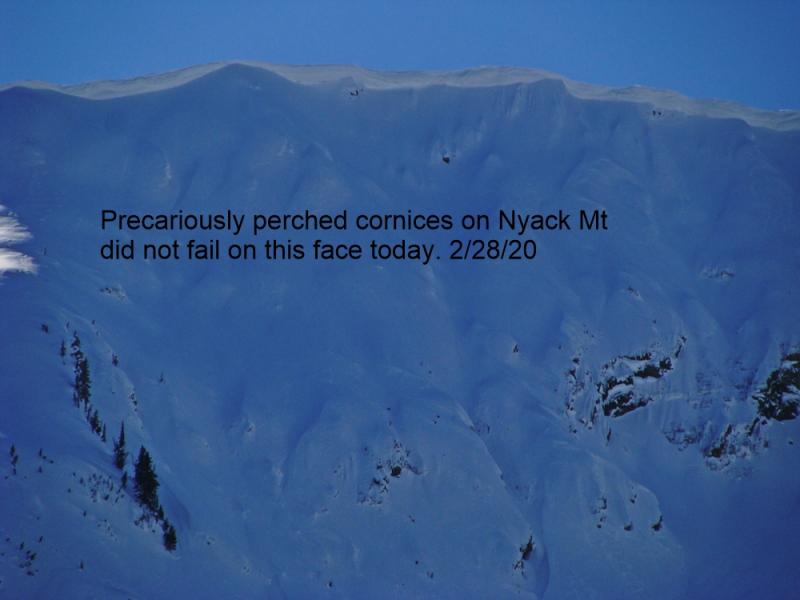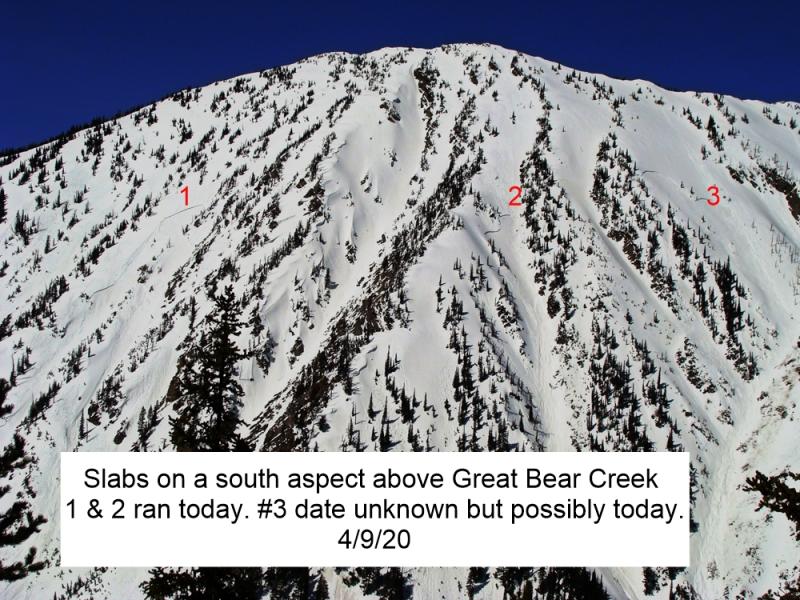| Friday | Friday Night | Saturday | |
|---|---|---|---|
| Cloud Cover: | Sunny. Well above normal temperatures. | Clear. | Sunny, then increasing clouds. |
| Temperatures: | 61 to 73 deg. F. | 37 to 45 deg. F. | 54 to 68 deg. F. |
| Wind Direction: | South-Southwest | Southwest | Southwest |
| Wind Speed: | 5-10 mph | 5-10 mph with gusts to 20 mph. | 10-15 mph. |
| Snowfall: | 0 in. | 0 in. | 0 in. |
| Snow Line: |
Whitefish Range
Swan Range
Flathead Range and Glacier National Park
How to read the forecast
Unusual conditions breeds unusual avalanches. Expected temperatures of 25 degrees above normal today are unusual for early April. This combined with no refreeze overnight will create dangerous avalanche conditions today. Expect natural and human triggered wet, loose avalanches on all aspects. Cornice fall could also trigger large avalanches on the slopes below. Destructive wet slab avalanches could also become a problem. The danger is CONSIDERABLE and could even rise to HIGH.

3. Considerable
?
Above 6500 ft.
3. Considerable
?
5000-6500 ft.
3. Considerable
?
3500-5000 ft.
- 1. Low
- 2. Moderate
- 3. Considerable
- 4. High
- 5. Extreme
-
Type ?
-
Aspect/Elevation ?
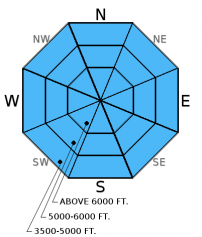
-
Likelihood ?CertainVery LikelyLikelyPossible
 Unlikely
Unlikely -
Size ?HistoricVery LargeLargeSmall

Expect both natural and human triggered avalanches today. They should begin rather early in the day given the lack of refreeze overnight at upper elevations. So, the bottom line for this problem is to avoid sunny slopes. Period. Then, carefully evaluate the snow surface on shaded aspects to determine how wet the snow is on those slopes. These avalanches could become large enough to bury a person today, especially in a terrain trap like a gully. As the day progresses, it would be wise to avoid all avalanche terrain.
-
Type ?
-
Aspect/Elevation ?

-
Likelihood ?CertainVery LikelyLikelyPossible
 Unlikely
Unlikely -
Size ?HistoricVery LargeLargeSmall

Recent warm temperatures and sunshine weakened the numerous large cornices in the area over the past week. Last Friday, a cornice fall on Nyack Mountain in the Flathead Range triggered a slab and resulted in a very large avalanche up to 5 feet deep (observation). Last Saturday, we witnessed another cornice fall that triggered a wind slab avalanche in the Swan Range (observation and video). On Monday, we noted another large slab avalanche triggered by cornice fall on Mt. Cameahwait in the Flathead Range. When they hit the slope below cornices are capable of triggering even deeper weak layers that would otherwise remain dormant in the snowpack. Cornices can pull far back from behind the ridge line making it important to keep an exaggerated distance away from the edge. Simply avoid traveling on the slopes below cornices as well today.
Also, numerous glide cracks exist throughout the advisory area and several have even failed. Forecasters with the Going-to-the-Sun Road outside the advisory area noted recent glide avalanche activity on upper elevation north aspects (observation and image). Whitefish Mountain Resort Ski Patrol reported widening glide cracks last week. Glide avalanches are very difficult to predict, so the best strategy is to avoid playing on slopes where glide cracks exist.
-
Type ?
-
Aspect/Elevation ?

-
Likelihood ?CertainVery LikelyLikelyPossible
 Unlikely
Unlikely -
Size ?HistoricVery LargeLargeSmall

Again, unusual conditions breed unusual avalanches, and I suspect we could see natural wet slab avalanches today. Wet slabs are difficult to predict. They require the right ingredients:
1. Weak snow somewhere in the snowpack (like facets around a crust)
2. Liquid water moving through the snowpack
3. A cohesive slab
We observed weak snow deeper in the snowpack around the late February crust as well as near the ground around a crust on southerly aspects with a relatively shallow snowpack. Given the intense warming and sunshine, I would not be surprised to see wet slab avalanche crowns throughout the advisory area over the next few days. Unfortunately, wet slab avalanches could occur on any aspect so today would be a good day to put the big objectives aside, keep the hill climbing at bay, and wait for cooler temperatures. It's a good day to go biking, rock climbing, or dirt biking.
Additional Concern: Watch for lingering wind slabs at upper elevations. Cornices falling on previously wind loaded slopes could cause large avalanches, and it is still possible for humans to trigger wind slabs at the upper most elevations.
The last advisory of the season will be issued on Sunday, April 10, 2016.
Thursday: The Going-to-the-Sun Road avalanche program reported substantial recent glide, wet loose, and soft slab avalanches just outside our advisory area in Glacier National Park (observation).
Tuesday: The Going-To-the-Sun-Road avalanche program reported up to 7 inches of new snow at low elevations with small wind slabs forming above 5500 feet. Impressive wet loose debris on all aspects was noted from the weekends above freezing temperatures (observation).
Monday: We traveled to the Tunnel Ridge area in the Flathead Range we observed the aftermath of the recent wet loose avalanche cycle on all aspects at mid and upper elevations. We noted a large wind slab avalanche triggerred by cornice fall on Mt. Cameahwait (observation).
Visit our Observations page and our You Tube channel for more observations from the entire season.
Thanks to everyone for submitting observations. They are extremely useful and could help save lives.
HOW TO SUBMIT OBSERVATIONS:
Email: [email protected]
Call and leave a message: 406.387.3821
You can also submit quick observations via text: 406.241.4571 (FAC mobile)
OR
Submit Snowpack Observations: http://www.flatheadavalanche.org/node/add/snowobs
Submit Avalanche Observations: http://www.flatheadavalanche.org/node/add/avyobs
I'm blatantly stealing a joke I saw from the National Weather Service-Missoula office yesterday (except they used Miami and Missoula). It's not quite as warm as Miam, but....it's still warm for early April.

Yesterday, temperatures climbed to the upper-40s to upper-50s F at most upper elevation stations. Only low elevation stations report freezing or close to freezing temperatures this morning. Currently, temperatures above 6000 feet range from 36º-43º F and winds are blowing out of the south-southwest at 3-7 mph with gusts to 11 mph. Today, expect temperatures to climb 20-25 degrees above normal to the upper 50s to mid-60s F in the mountains. Winds will move out of the southwest at 5-10 mph. Expect some cooling tomorrow with clouds entering the area in the afternoon.
| 0600 temperature: | 36 to 43 deg. F. |
| Max. temperature in the last 24 hours: | 42 to 58 deg. F. |
| Average wind direction during the last 24 hours: | Southwest |
| Average wind speed during the last 24 hours: | 1-13 mph |
| Maximum wind gust in the last 24 hours: | 12-21 mph |
| New snowfall in the last 24 hours: | 0 inches |
| Total snow depth: | 75-111 inches |
This advisory applies only to backcountry areas outside established ski area boundaries. This advisory describes general avalanche conditions and local variations always occur. This advisory expires at midnight on the posted day unless otherwise noted. The information in this advisory is provided by the USDA Forest Service who is solely responsible for its content.













